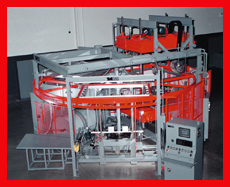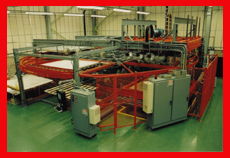|
THERMOFORMING: The Rotary Advantage
The Rotary Thermoforming
Machine has seen
constant improvements
and continues to be the
fastest standard sheet fed
thermoforming machine manufactured
in the country. As it
continues to gain popularity,
it is persistently being adapted
to gain more and more
advantages over other types
of sheet fed thermoforming
machines. The rotary is mainly
utilized for mid to high volume
production of parts,
which is its single largest
advantage.

The latest rotaries
offer many additional advantages that allow users to gain
a competitive advantage, not only by having high production
capabilities but much more. The additional benefits
can be overlooked by companies not aware of them,
whether they are utilizing a rotary or competing with one.
The improved designs and technology implemented in the
rotary have made it a much more versatile machine.
More Parts Per Hour / Energy Savings
Rotaries guarantee more capacity and faster cycle
times while utilizing less electrical consumption per part
when compared to a single station or shuttle type
machine. This is due to the fact that a rotary machine
continuously has a sheet in the oven, as all stations are
being utilized simultaneously. In a three station rotary,
after unloading a finished part from station 1, the next
sheet is loaded back into the station, meanwhile station
2 is being heated and station 3 is being formed. This
allows the rotary machines to be capable of producing
product with 1/3rd the amount of oven energy that a single
station would require. While utilizing a rotary, the
cycle time is either dictated by the heating time or cooling
time, whichever is longer. The constant is 2.8 to 3
times the parts per hour output with oven electrical consumption
equal to a single station. This makes the rotary
machine more energy efficient. With faster cycles, less
machine time is needed, allowing companies to spend
fewer hours, use less energy per part and less labor while
at the same time, gain machine time and capacity.
More Consistent
and Repeatable
The Rotary machine can
ensure high daily outputs
regardless of the operator’s
influence. The machine’s cycle
time is not dictated by the
time it takes the operator to
load and align a sheet and
unload a finished product like
it is on a single station. The
operator running a rotary is
required to load and unload
within the products cycle
time, therefore allowing thermoformers
to be more constant
with higher productions as well as more consistent
with finished products.
Since a rotary cycles constantly, based on a pre-set cycle
time, the atmosphere within the oven also remains very
consistent. This oven consistency makes the rotary a
favorable machine with some of the new applications and
materials that require tight and repeatable temperatures,
such as paint films. Since materials are becoming much
more advanced, the oven consistency provides a more reliable
oven, therefore making it much easier to hold tighter
tolerances.
The finished part consistency of the rotary is beginning
to force some of the lower volume applications to be utilized
exclusively in this type of machine.
Although most thermoformers utilize water-cooled aluminum
molds when running a rotary machine, shorter
runs with ceramic, resin, fiberglass or non water-cooled
molds are still possible with a rotary. The limiting factor
when using a non temperature controlled mold is overheating
it. The machine can be slowed down to accommodate
this type of situation, but cooling the tool will be
the deciding factor on the cycle time.
Furthermore, the new rotaries are programmed to allow
formers to use a skip frame technique, which will form a
part every other cycle, allowing the mold additional time to
cool. By not loading a sheet into station one; the machine
will remember not to perform any function when that station
reaches the forming area. Although this may not be an
ideal procedure, formers with high and low volumes can still adapt to their marketplace and utilize the consistency
of a rotary. You can also simply slow down the rotary, or just
apply the right amount of cooling to your tool, depending
on your specific applications.
With the higher demand of lower volume rotary applications,
machine manufacturers have quickly implemented
features that allow machine changeover times to be drastically
reduced. Three station rotaries can be changed
over in less than 35 minutes with the use of adjustable
clamp frames, mold centering and securing devises and
the latest in machine controls. Preheated tooling is also
becoming more common for even faster part to part
changeover times.
Several advantages of recent model rotary machines are
apparent with machines that have a high sheet line and lift
table system for semi-automatic bottom loading and unloading
of parts. Older rotary designs that have low sheet-lines
and are top loaded manually do not provide as many advantages,
nor do traditional single stations or shuttles that are
toploaded.
Safety
Safety is a primary benefit of the overhead design of a
high sheet line machine with a semi-automatic loading
devise or lift table. This feature removes the possibility of
placing hands into the clamp frame when loading and
aligning sheets of plastic. It also reduces the risk of touching
hot clamp frames and machine components that cycle
through the oven. This design also
greatly reduces the risk of personnel
walking into the rotating carousel. As
most thermoformers running single
stations and top load machines know,
burns, pinched fingers or any type of
injury can get expensive.
The “no pit design” also eliminates
the need for personnel to enter a pit
for maintenance purposes, which
helps to reduce the risk of an accident
occurring. The “no pit design” allows
for a quick and easy installation and
gives the flexibility of moving the
machine around your facility instead
of being forced with a permanent
machine location due to a platen pit
requirement. The “no pit design” also
tends to improve housekeeping of
your facility.
Floor Space
Floor space is a valuable item in
today’s thermoforming facilities.
Another reason the high sheet design
is preferred, is it creates additional
floor space for loading, unloading and
trimming. With room for a skid of
material (usually on the right side of
the load/unload station), loading and
unloading can be accomplished within
the perimeter of the machine. The high sheet line design
allows you to incorporate the vacuum reserve tankwithin
the machine’s parameter, therefore eliminating the need
for any additional floor space.
Easier on the Operator
The ergonomic high sheet line design, coupled with the
lift table, eliminates the need for an operator to bend over
to load and unload material. With a stack of material to
the right or left of the lift table, an operator can ergonomically
slide sheets onto the lift table instead of carrying or
lifting sheets. Since the lift table also retrieves the formed
part when the cycle is complete, the operator can also
select what height he wishes to unload the part, once
again making it easier on the operator.

A larger selection of machine operators can also be
considered to operate these machines as they no longer
need to have the 3-foot arm span that is typically needed
to reach over the clamp frames to load any top load style
of machine. Since lifting is kept to a minimum, the operator
can also be less physically fit and still keep up with
production.
Since the operator has less physical stress and can load
much quicker, additional free time becomes available.
This can allow operators to do better secondary operations
or additional operations such as: quality assurance,
trimming or even tweaking the machines parameters for
more efficiency.
Smaller Sheet Sizes and Lower Scrap Rates
Loading sheet is more precise by the use of a lift table
and sheet guide system. Sheet material is easily positioned
onto the lift table; adjustable stops are provided for
repeatable positioning of sheet into the clamp frame.
Sheets can be loaded much more accurately and repeatably,
which nearly eliminates sheet “pullouts” or clamping
of unaligned sheets, which are two major causes of
increased scrap rates. On low sheet line, top load
machines the operator is responsible for the continual
alignment of loading sheets accurately, therefore allowing
for more error or more scrap.
The precision lift table in conjunction with good clamp
frames requires only the minimum blank size of material.
By loading sheets more accurately and repeatably you can
reduce the material blank size by 6% to 12%. With low
sheet line, top load machines most formers oversize the
starting dimensions of their sheet to accommodate the
operator on loading and aligning of the sheet. They have
found the larger sheet size reduces operator error and
lowers scrap, but the bottom line is it still adds cost to use
a larger sheet size.
The thermoforming manufacturing world is now being
forced to use the most efficient procedures and equipment
in order to maintain its competitive edge in today’s marketplace.
Lower labor costs, lower material costs, lower
energy costs, shortest changeover times and improved
part-to-part consistency are all the main reasons our marketplace
is making changes and why the latest rotary
technology is being further implemented and utilized.
For more information, click on the Author Biography link at the top of the page.
|